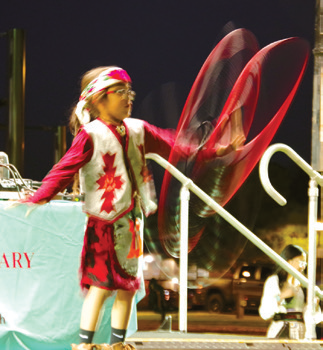Page celebrates second annual Indigenous Peoples’ Day
- Phil Clark

- Oct 25, 2023
- 3 min read
On October 16, Page Public Library and the City of Page sponsored the second annual Indigenous Peoples’ Day at the John C. Page Memorial Park. This year, the library and city staff outdid themselves. The weather was as good as it gets in the high desert for the celebration. The lawn of the city park filled with performers, speakers, vendors and spectators for the evening’s celebration.
Native Americans and non-natives gathered in the park and on the lawn or in chairs they brought with them to listen to stories, music and history of the Dine’ or Navajo people. Mother Nature smiled on the event with a calm and pleasant temperatures.
Left to right, photos by Phil Clark:
A group of students sing native songs to the audience.
A young dancer demonstrated the hoop dance to the audience at the Indigenous Peoples’ Day celebration.
Dale Tsosie plays native tunes on a hand-made flute at the celebration.
After the National Anthem, sung by Calla Smith, and Pledge of Allegiance, led by the UNITY Club, Mayor Bill Dyak welcomed everyone in attendance and started the festivities. The Navajo speakers and performers each introduced themselves in the traditional Navajo way, including their clans. Every Navajo person has four clans. The first clan is the mother’s clan. The second is the father’s clan. The third is the maternal grandfather’s clan and the fourth is the paternal grandfather’s clan.
Lena Fowler, Coconino County Supervisor, introduced herself in Navajo and described how, as a child, she was punished for speaking her native language while attending boarding school. She remembers going to the river with her family to make an offering and to gather salt. She has retained her knowledge of the variety of plants and herbs of the area, and follows the traditions of her people. Fowler described how the upcoming eclipse is a time for reflection, renewal and respect as the traditional Dine’ stay indoors during any eclipse.
According to Fowler, she ran for county supervisor in 2009 “to create change so we can have a more positive society.” Fowler described how her family got their last name from a government census taker. She went to boarding school and described how she and her fellow students weren’t allowed to speak Navajo. Fowler says we have come a long way, but more needs to be done to reduce the inequities between natives and non-natives, including the disproportionate number of incarcerated native people.
Fowler says that since she has been baptized in six churches, she respects and works with the various churches. Fowler prays often for people to have kind words and thoughts about each other. She believes we can learn from each other and about each other.
The program included singers and dancers from the area including the Baboquivari Unified School District, Kayenta Unifi ed Schools and the Page Schools UNITY Club. Dale Tsosie, a Navajo flutist, serenaded the audience complementing the calm and pleasant evening with music that captivated and charmed those in attendance. No celebration is complete without some dancing. Dancing is part of Native American tradition. While ceremonial dances are not performed in public, “Pow Wow” dances such as the round, hoop, grass and jingle dress dances are. Pow Wows themselves were created as a way to unite the various Native American tribes by performing dances together. For this celebration, dancers performed the Navajo Round Dance that encourages all members of the audience, native and non-native alike, to dance together.
While the speakers spoke and the dancers danced, Rimview Terrace served Navajo fry bread. Fry bread is a popular food item for many and before the end of the event, there was no more fry bread. Standing in line was a good way to meet other people and continue to watch and listen to the program.
The second annual Indigenous Day Celebration was a lot of fun. Many in the audience were glad it was even better than last year and look forward to attending next year as it seems to be a new annual tradition.










